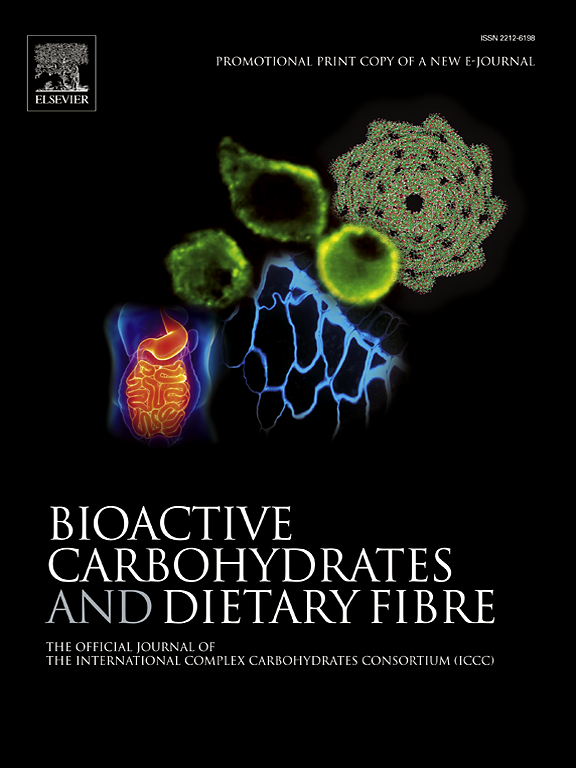Enterococcus hirae OL616073 glucan exopolysaccharide based cumin oil emulsion: Characterization and antibacterial activity
IF 3.6
引用次数: 0
Abstract
This study aims to prepare the cumin essential oil-based emulsion stabilized by glucan exopolysaccharide (EPS) from Enterococcus hirae OL616073. The emulsion was prepared by optimizing different ratios of EPS to essential oil via vortexing, ultrasonication, and high shear homogenization. The concentration of EPS (among 0.5, 1, 1.5, and 2 %) and the ratio of EPS to essential oil (among 1:0.5, 1:1, 1:1.5, and 1:2) were initially optimized using vortexing. Ultrasonication and high shear homogenization processes were applied to the vortexed samples and optimized the concentration of EPS and the ratio of EPS to essential oil combinations. The emulsion capacity, emulsion stability, the effect of various processing parameters (temperature and salt), and antimicrobial activity were determined for the emulsions prepared from vortexing, ultrasonication, and high shear homogenization. It was found that emulsion capacity and emulsion stability were better in ultrasonication and high shear homogenization treatment compared to vortexing. When these emulsions were treated with various temperatures and the effect of ionic strengths, the order of emulsion stability was recorded as ultrasonication > high shear homogenization > vortexing. Further, there was significant antimicrobial activity against four tested pathogens, namely Listeria monocytogenes (MTCC 1143), S. aureus (MTCC 1144), E. coli (MTCC 433), and Shewanella putrefaciens (MTCC 8104), but no antimicrobial activity against Salmonella enterica (950) was observed. Parameters such as type of emulsion, turbidity, pH, Fourier transform infrared (FT-IR) analysis, and microscopic analyses were also performed for emulsions. This EPS-based emulsion system can be further explored for functional applications in the field of food and health.
产肠球菌OL616073葡聚糖外多糖基孜然油乳剂:表征及抗菌活性
本研究的目的是制备以产自霍乱肠球菌OL616073的葡聚糖外多糖(EPS)为稳定剂的孜然精油乳液。通过旋流、超声和高剪切均质等方法优化EPS与精油的不同配比,制备出乳液。采用涡流法对EPS浓度(0.5、1、1.5、2%)和EPS与精油的比例(1:0.5、1:1、1:1.5、1:2)进行初步优化。采用超声和高剪切均质工艺对旋涡样品进行处理,优化了EPS的浓度和EPS与精油组合的比例。对旋涡、超声和高剪切均质法制备的乳化液进行了乳化液容量、乳化液稳定性、不同工艺参数(温度和盐)对乳化液抑菌活性的影响。结果表明,超声和高剪切均质处理比涡旋处理具有更好的乳状液容量和稳定性。在不同温度和离子强度的作用下,乳状液的稳定性依次为:超声处理;高剪切均匀化>;涡流。此外,对单核增生李斯特菌(MTCC 1143)、金黄色葡萄球菌(MTCC 1144)、大肠杆菌(MTCC 433)和腐坏希瓦氏菌(MTCC 8104) 4种病原菌均有显著的抑菌活性,但对肠沙门氏菌(950)无抑菌活性。乳化液的类型、浊度、pH值、傅里叶变换红外(FT-IR)分析和显微分析等参数也被用于乳化液。该乳液体系在食品卫生领域的功能应用前景广阔。
本文章由计算机程序翻译,如有差异,请以英文原文为准。
求助全文
约1分钟内获得全文
求助全文
来源期刊

Bioactive Carbohydrates and Dietary Fibre
Agricultural and Biological Sciences-Food Science
CiteScore
6.00
自引率
0.00%
发文量
38
期刊介绍:
 求助内容:
求助内容: 应助结果提醒方式:
应助结果提醒方式:


